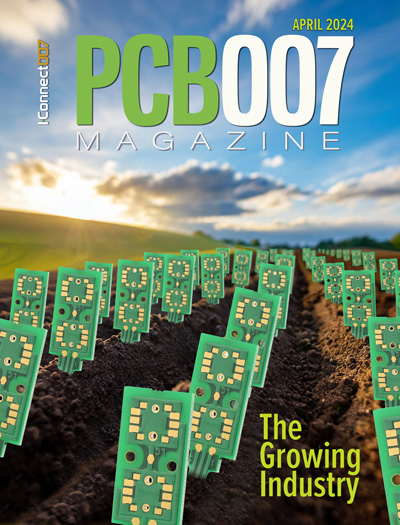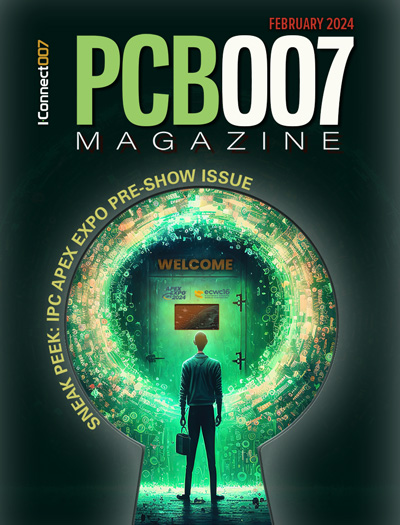-

- News
- Books
Featured Books
- pcb007 Magazine
Latest Issues
Current Issue
The Growing Industry
In this issue of PCB007 Magazine, we talk with leading economic experts, advocacy specialists in Washington, D.C., and PCB company leadership to get a well-rounded picture of what’s happening in the industry today. Don’t miss it.

The Sustainability Issue
Sustainability is one of the most widely used terms in business today, especially for electronics and manufacturing but what does it mean to you? We explore the environmental, business, and economic impacts.

The Fabricator’s Guide to IPC APEX EXPO
This issue previews many of the important events taking place at this year's show and highlights some changes and opportunities. So, buckle up. We are counting down to IPC APEX EXPO 2024.
- Articles
- Columns
Search Console
- Links
- Events
||| MENU - pcb007 Magazine
The Newest Flex Shop in the U.S.
July 7, 2016 | Barry Matties and Angela Alexander, I-Connect007Estimated reading time: 27 minutes
I-Connect007 sales team member Angela Alexander and I recently got a tour of Lenthor’s new Silicon Valley flex board shop and then sat down with President and CEO Mark Lencioni to discuss the new flex facility, the markets, management, and the future.
Barry Matties: Mark, give our readers a little background on Lenthor Engineering and what you do.
Mark Lencioni: We are entering our 31st year of business; having been founded in 1985. We are now located in our brand new, 55,000 sq. ft. state-of-the-art facility dedicated specifically to the fabrication and assembly of flex and rigid-flex products. We made it as “Lean” as possible for all our manufacturing systems to be very close to each other, in order to get the most efficiencies with our employees and product movement. It came out just like we planned.
Matties: So is Lenthor a flex shop primarily?
Lencioni: Yes, we specialize in flex circuit fabrication and assembly. We specialize in multilayer and rigid-flex technology, very high aspect ratios, high layer counts, and the technology to allow packaging to get into the size and shape it needs to be. We have succeeded by satisfying the toughest demands from the most demanding customers in the world.
Matties: Flex is still one of the fastest growing areas in the marketplace.
Lencioni: Yes, our customers’ products are the largest they will ever be and flex circuits are a natural solution to help people package things in the size and shape they need to be. They're getting smaller and smaller. From wearable devices, to cellphones, to any kind of mechanical device, automotive, military equipment, and some semiconductor equipment processing.
Matties: In your 30+ years, what's the most surprising thing you have seen in the flex market?
Lencioni: I would say the growth in both medical and military. We didn't really appreciate the opportunity these markets held for us until we did some specific market research after 9/11. The results of that research are what led us to move more heavily into these markets. If you look at the world and the environment we are in, these marketplaces are poised to be well-established for many, many years to come.
Matties: Your facility is an ITAR facility; what's the percentage of work that you bring through here?
Lencioni: We are about 55% military, 25% medical, and the rest balances across industrial and telecom.
Matties: Where do you see the largest growth coming from right now?
Lencioni: Military and Medical. Military obviously is in a very stable environment because it doesn't go offshore. We are finding growth from within a market that we are already well positioned to support. The medical market is also very favorable for us. We have developed the kind of process validation and control that market insists on.
Matties: Going back to your new facility, who laid out the facility?
Lencioni: It was a combination of Rich Clemente and myself. We took the processes, and with help from engineers regarding where they needed to be, we just started to lay it out. We did that with an architect, and so whatever building we decided to go into we just took that footprint and laid it right in.
Matties: When you are laying out a facility like this, what's the goal?
Lencioni: The goals were product efficiency and people movement. To really make sure that the product started finished within the most efficient process path, minimizing as best we could the movement and handling of materials.
Matties: When we first started the tour we talked about your old facility and the length of that process.
Lencioni: Yes, we had a campus environment previous to this which included three separate buildings. Although they were across the parking lot from each other, the movement of materials from beginning to end was about 2.2 miles. We re-validated what it is in our new factory and depending on product type the movement is down to about one eighth of a mile. The product moves with more efficiency, it doesn't get mishandled, and the employees are able to stay focused on their job of producing boards instead of moving materials.
Page 1 of 5
Suggested Items
Insulectro’s 'Storekeepers' Extend Their Welcome to Technology Village at IPC APEX EXPO
04/03/2024 | InsulectroInsulectro, the largest distributor of materials for use in the manufacture of PCBs and printed electronics, welcomes attendees to its TECHNOLOGY VILLAGE during this year’s IPC APEX EXPO at the Anaheim Convention Center, April 9-11, 2024.
ENNOVI Introduces a New Flexible Circuit Production Process for Low Voltage Connectivity in EV Battery Cell Contacting Systems
04/03/2024 | PRNewswireENNOVI, a mobility electrification solutions partner, introduces a more advanced and sustainable way of producing flexible circuits for low voltage signals in electric vehicle (EV) battery cell contacting systems.
Heavy Copper PCBs: Bridging the Gap Between Design and Fabrication, Part 1
04/01/2024 | Yash Sutariya, Saturn Electronics ServicesThey call me Sparky. This is due to my talent for getting shocked by a variety of voltages and because I cannot seem to keep my hands out of power control cabinets. While I do not have the time to throw the knife switch to the off position, that doesn’t stop me from sticking screwdrivers into the fuse boxes. In all honesty, I’m lucky to be alive. Fortunately, I also have a talent for building high-voltage heavy copper circuit boards. Since this is where I spend most of my time, I can guide you through some potential design for manufacturability (DFM) hazards you may encounter with heavy copper design.
Trouble in Your Tank: Supporting IC Substrates and Advanced Packaging, Part 5
03/19/2024 | Michael Carano -- Column: Trouble in Your TankDirect metallization systems based on conductive graphite or carbon dispersion are quickly gaining acceptance worldwide. Indeed, the environmental and productivity gains one can achieve with these processes are outstanding. In today’s highly competitive and litigious environment, direct metallization reduces costs associated with compliance, waste treatment, and legal issues related to chemical exposure. What makes these processes leaders in the direct metallization space?
AT&S Shines with Purest Copper on World Recycling Day
03/18/2024 | AT&SThe Styrian microelectronics specialist AT&S is taking World Recycling Day as an opportunity to review the progress that has been made in recent months at its sites around the world in terms of the efficient use of resources:


